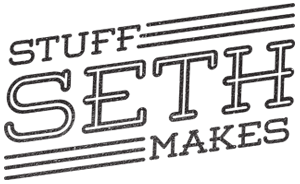.jpg)
You may remember a modern serving board I designed a while back called The Monroe serving board. I had a few of these boards in my Etsy shop and my wife and I took some with us when we did our first craft show last year. The boards have proven to be a popular item and because of their unique shape and overall design they also struck a chord with a chocolatier up in the PNW.
I was asked if I could make three dozen of my Monroe boards, half of which would be the regular size I’d made before and the other half would be a mini, approximately half size of the original.
In order to make the process as streamlined as I could, I needed a way to reproduce these over and over. “Well Seth, don’t you have a cnc machine?” Yes I do, but it’s not really as easy as all that, and I’ll explain why in a moment. I needed to do these manually, one at a time, and a couple templates and jigs would be the way to go.
To start off, let me explain why I don’t think using my cnc is the right option for this project. When I bring the raw walnut lumber in, I trace the templates onto the walnut so I know how many I can get out of that piece of walnut. I trace them out in the best grain direction while avoiding knots and cracks. This is why I can’t use the cnc. I COULD use the cnc if I was starting with flawless walnut lumber but it doesn’t make a lot of sense to create a new g-code file for every single board.
.jpg)
So templates it is! I made a basic template for the large size and the small size. This template allows me to cut out the Monroe boards using a Freud pattern bit at the router table.
.jpg)
To create the dished out recessed area on the Monroe boards, I used a bowl and tray router bit from Whiteside. This router bit has a flat end with a radius, and also has a guide bearing. In addition to the template I made to cut out the shape of the boards, I made another template where I’ll follow the inside shape with the bowl and tray bit.
.jpg)
To use the bit, you use it mounted in a plunge router. I use the Bosch 1617EVSPK with the plunge base installed and I plunge it down a little bit at a time, allowing the bearing to follow the template. In my case, it took 3 fairly conservative passes to get to my final depth and the bowl and tray bit leaves a nice radius edge along the bottom. Whiteside sells the bowl and tray bit with a 1/2″ shank with 1-1/4″ cutting diameter as well as a version with a 1/4″ shank with 3/4″ cutting diameter. I have both but the larger one removes more material faster 🙂
.jpg)
I also drilled a hole in the template so that I can use an awl and mark where the “beauty mark” will be. For the finger hole in the handle I have another little template I slide over the handle and mark the spot so I can drill it out using a forstner bit later.
.jpg)
.jpg)
To cut the Monroe boards to their final lengths I set up a quick angled stop block. Using that stop block allowed me to make the angled cuts quickly and easily. After that I soften the sharp points over at the oscillating sander, and then I use a roundover bit to address the edges all around.
The next little jig I made and used is actually more of a sled that I use over at my HE&M 782XL metal cutting bandsaw. The “beauty marks” were brass rod on the original but on this order they’re stainless steel. The sled I made has a runner on the underside so it can slide forward and backward in the track on the bandsaw table. This sled allows me to insert the steel rod into a hole with a stop on the other side so each cut is the same length. As I slide the sled forward, the cut is made and I’m left with little stainless steel cutoffs. Cuts like these can be a little risky but this sled also allows me to keep my fingers safe during the cuts. Now I can epoxy the beauty marks into the boards.
.jpg)
The final jig or template (sorry I don’t really know if this would be considered a jig or a template, haha) is a small piece I screw into the opposite side of the bowl/tray template. This piece is for the alignment of the branding iron. With this piece screwed in place I can be sure the branding iron lands in the same place every time, and I have this setup for the large boards and the small boards. Now I can fire up the torch and brand the boards!
.jpg)
.jpg)
.gif)
Finally, the Monroe boards get dunked in a tub of food grade mineral oil. Once they’re wiped and dry I use Walrus Oil brand wood wax as a final finish. The Walrus Oil wax is a great option for finishing any kind of wooden kitchen utensils, serving boards, charcuterie boards, end grain cutting boards….all that good stuff! Then I can screw in the little rubber feet and they’re done!
.jpg)
.jpg)
.jpg)
.jpg)
I hope this information has been helpful! I’ve got an in-depth video that may be extra helpful to see all this information in action. Check out the whole video about using templates, jigs and router bits here, and I hope you’ll consider subscribing to my YouTube channel. and also be sure to follow me over on Instagram. I’ve got a lot more video content coming up and I would love for you to be able to see it!
More than one time I’ve heard people in the maker community say something like “sometimes we’ve gotta make the things in order to make the things!” That is so very right. I think I love making those other things just as much as I love making the things I set out to make in the first place! I’m excited to share this info with you and maybe it will give you some ideas when it comes to designing your own serving boards. The following links will take you to some items in my Amazon storefront that I used on this project. As an Amazon Associate I earn from qualifying purchases, and any earnings I make through the following links will help me to continue creating content to share here and on my YouTube channel. I appreciate you all purchasing stuff via my links!
Thanks for stopping by and I hope you’ll come back for more!







